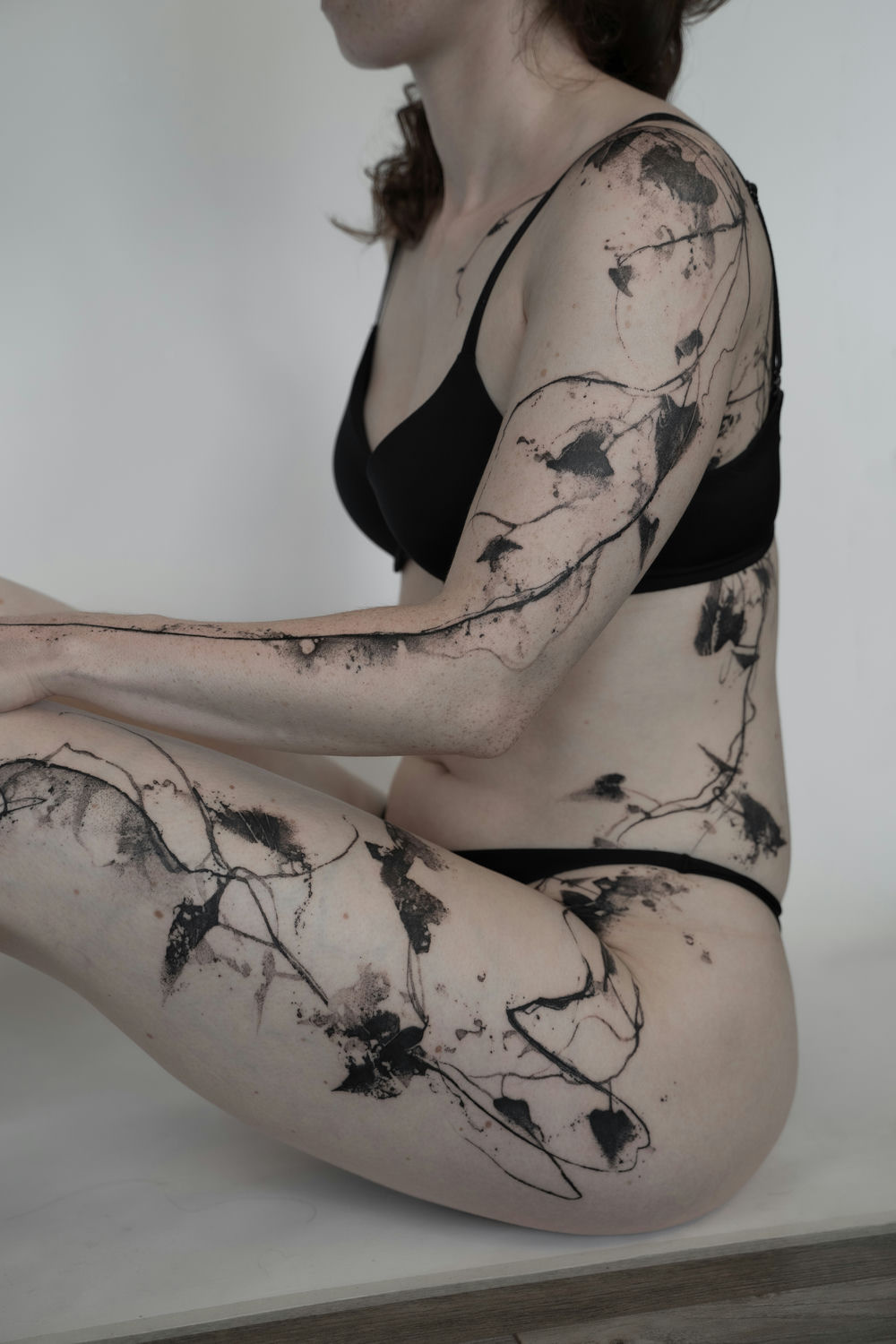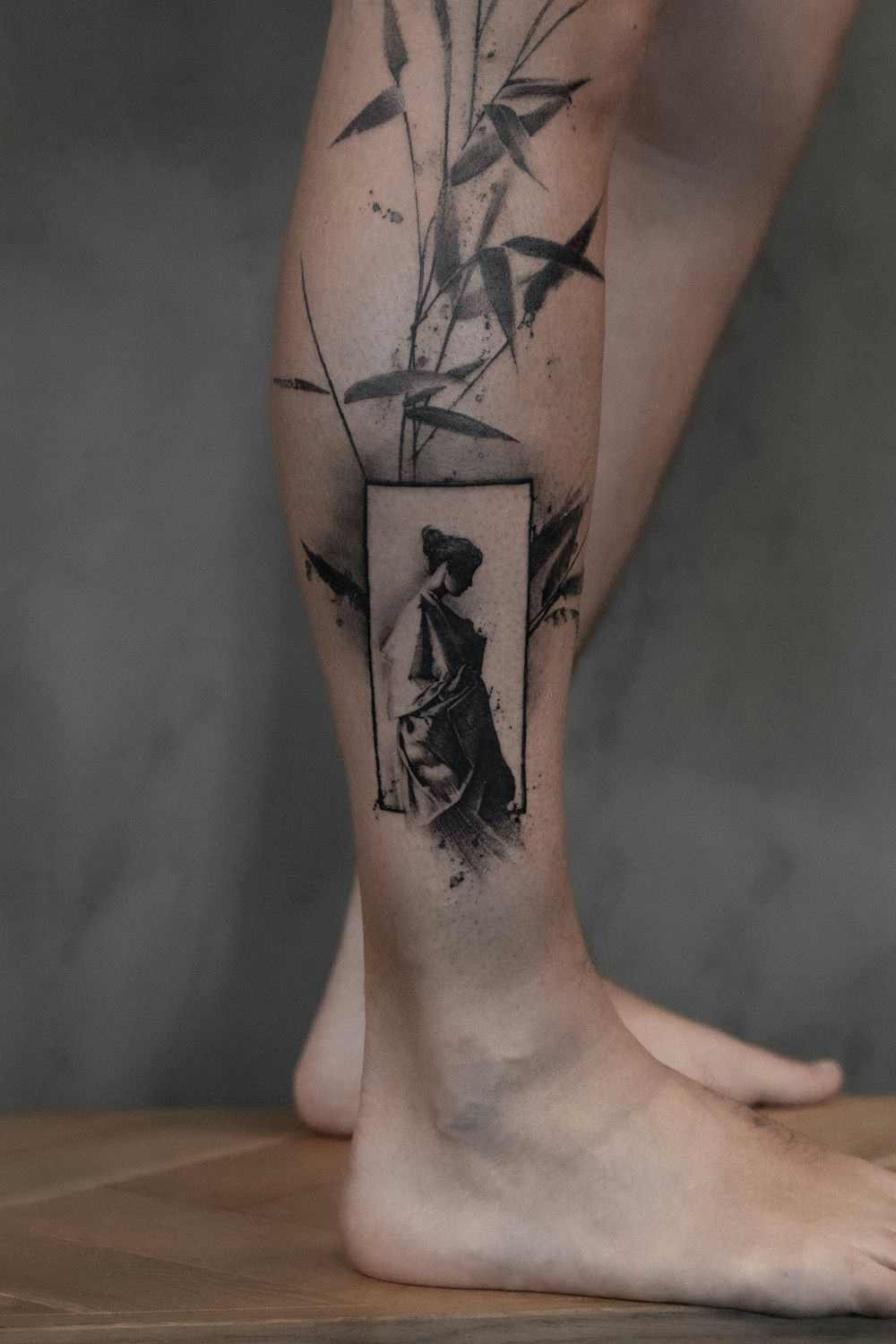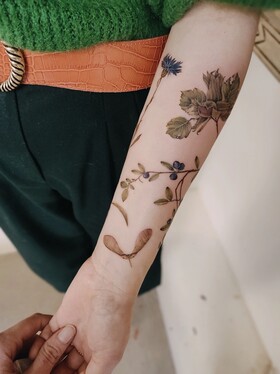The world of tattoos is a space where traditional art meets individuality and innovation. Among those who boldly push the boundaries and break stereotypes is Edvin Tedebring, an artist of abstract and semi-realistic tattooing based in Copenhagen. His unique style reflects not only an aesthetic vision but also a deep artistic philosophy. Each of his works is a combination of creative freedom and a highly technical approach, turning the body into a living canvas for abstract masterpieces.
How did your journey into tattooing begin, and what first drew you to the art form?
- I think I was caught by Miami Ink and similar TV shows as a young teenager. Tattooing fascinated me, and I realized early on that I wanted to get into the industry. I started adjusting my drawings to be like tattoo motifs, and the dream about making a career in tattooing kept growing. Years later, I went to university, studying Digital Media Production because I am very into tech and digital design as well. I also knew that if I was going to get into tattooing, I was going to do it seriously from the start and get an apprenticeship. If I didn't get an apprenticeship, I would go for a career in graphic design or UX/UI design. During my uni years, I started getting tattooed frequently by Brent McKenzie, a tattoo artist in my hometown Umeå. We saw each other almost every month for a while, and he started guiding me in designing tattoos and drawing. Upon finishing my bachelor's degree, I became his tattoo apprentice in 2017.

Your style is very unique and abstract. How would you describe your tattooing style in your own words, and what do you call it?
- I usually call it abstract black-and-gray and semi-realism. I focus a lot on texture, flow, and contrast.
What influences or artists (tattoo or otherwise) have shaped your approach to tattoo design?
- There are many over the years, but I think classic abstract painters like Pollock, Rothko, and Kline inspired me due to the perceived arrogance of their work. People didn't understand it at the time because it was unconventional. That point alone is inspiring to me, aside from expressional inspiration, because I feel like tattooing has repeated itself a lot over the years, and I wanted to find my own voice through my designs.

You often work freehand without a stencil. Can you explain how that process works for you, and what excites you about it?
- To be in full control of placement, size, and flow, drawing the designs freely onto the skin is the best way, in my opinion. If I have a prepared design, it might not always fit like I want, leading me to draw it on instead. After discussing with my collector the approach we are going for, I just let the design come to me as I sketch on their body with markers. The marker drawing I make on them is always quite general and depicts only the movement and flow of the piece. When I tattoo this design, it evolves through the process. Even when I have a reference, I never follow it exactly. The tattoo happens during tattooing for me.

Tattooing requires both technical skill and creativity. How do you maintain a balance between precision and artistic expression?
- I think it's much about knowing yourself and what you're capable of, and from that, realizing what you are probably capable of. To develop, I regularly challenge myself and push my boundaries, both in designing and tattooing techniques. I am very analytical, and if I am going to do something I haven't exactly done before, I can understand beforehand how it needs to be done and then do it. It's essential to develop artistic expression but to do so at a pace that allows for the technical skills of tattooing to keep up.

Abstract tattoos are often deeply personal. How do you collaborate with clients to create a meaningful piece for them?
- My collectors usually express the meaning or emotions behind their tattoo idea, and from there on, I interpret that into my abstract pieces. I usually hide little gems in the design, like natural textures, circles, lines, or something else that particularly connects to their meaning. The meaning is then hidden, only for them to know, which makes it more personal, in my opinion. It is an interesting collaboration, and my collectors have great trust in me.

How do you keep your designs fresh and avoid falling into repetitive patterns?
- By constantly looking forward and looking to improve. I never do the same design twice, and if I notice a pattern in my requests, I always start pushing away from becoming repetitive. I strive to create unique pieces for each of my collectors, and while being inspired by something they saw me do before, I emphasize the importance of uniqueness for their piece.

Tattoo placement plays a big role in your designs. How do you approach choosing the right spot for a tattoo?
- I think placement is pretty much everything in every tattoo. Oftentimes my collector has a vision for what placement they want, and it is usually good as a starting point, but almost every time I suggest an alternative, whether that is extending it somehow or even choosing a completely different placement. I want my tattoos to look the best they can, and limiting myself in terms of placement will alter the entire final look.

What challenges do you face when translating abstract ideas into permanent body art?
- Most of my collectors trust my process confidently, but some people can have a hard time with the fact that they cannot know exactly how the tattoo will look once finished. This is always resolved through clear communication.
What do you think is the most misunderstood aspect of abstract tattooing?
- That doing abstract is easy, and you do it only because you cannot do anything else. I learned a lot of things before I started learning abstract. I can pull off a great variety of styles, but I focus on the abstract because I like it, and it has a complexity that not every tattoo artist appreciates.

Do you have a favorite tattoo you’ve created, and if so, what made it special?
- I don't think I have one favorite piece, but I do like a lot of the semi-realistic faces combined with abstract elements that I have done. I like the way a certain facial expression sets the mood of the design and how the abstract adds an additional layer to that narrative. These types of designs are something I want to focus more on in the future.

What has been your most challenging project to date, and how did you approach it?
- I don't think I can name one, but complex cover-ups and hiding scars are always challenging. My approach to these projects is always straightforward communication. I need my collector's trust to reach a result that is good and fills the purpose. If they are not willing to take my advice, I will not proceed with the project.
You currently work at a tattoo studio in Copenhagen. Can you tell us more about the studio, the team, and the atmosphere?
- I work at Dropout Collective, which is the biggest place I have ever worked in. It has about 18 tattoo artists now (I think), and despite the number of people, it offers a calm and inviting atmosphere. It is a very creative team of artists, and I would say just about every style is being made under our roof. We work on an appointment-only basis to ensure full focus on the collectors visiting and to maintain a relaxing environment.

Do you find inspiration from your surroundings in Copenhagen? How does your environment influence your work?
- Copenhagen has a particular vibe. It has a big city energy and a small town energy. It is calm yet highly active. It is professional, creative, and low-key. This vibe the city offers inspires me and my workflow. Copenhagen resonates with me a lot.
How do you see the tattoo industry evolving in terms of abstract and experimental styles like yours?
- I can see a rise in these styles, for sure. Unfortunately, I see a lot of copycats out there in this realm of styles, which is always sad. To me, abstract is one of the most creative styles, and copying other artists' work is the least creative thing you can do. So, while I am pro the development of abstract tattoos, I hope artists go their own way and develop their own styles.

Have you ever thought about collaborating with artists outside the tattoo industry or even brands? If so, which ones would interest you?
- I have, yes. I would be interested in collaborating with fashion, interior, or jewelry brands, for example. I think there would be interesting and unique ideas to explore in such collaborations.
As an artist with a non-traditional tattoo style, how do you view tattoo conventions? Do you participate in them, and what’s your take on their role in the industry?
- I have participated in conventions a few times, and I believe that currently they are not quite the place where abstract styles such as mine are widely appreciated. Of course, if I or anyone wanted these styles to become part of the conventional tattoo world, we would need to take those steps ourselves. I personally think that conventions are more for tattoo artists than for collectors. In my experience, it is a social but fairly casual event where the focus is not on the collectors but on the artists. It is an opportunity to network and meet other artists, and I think it's great for the community as a whole. However, when it comes to working, I prefer meeting my collectors in a relaxing studio environment where I choose the music, and we have our own space and atmosphere.

What advice would you give to aspiring tattoo artists who want to develop their own unique style?
- I would say focus on your quality first. Developing your own style comes way later than you think. Put the first 3-5 years into working as much as you can and get good. Get really good. Becoming a one-trick pony from the start is going to be the end of your career. I have changed my style numerous times, and each time I thought I knew what I wanted to do. My point is, if you are in your first 1-2 years, what you think you want to do in terms of styles now is most likely going to change and change again.
Lastly, what are your future plans? Any new projects, collaborations, or ideas you’re excited to explore in the coming years?
- I am planning to keep working hard and smart, developing my brand to what I want it to be. I have a lot of big future plans, but I am not sharing them until the time is right.








Comments (0)